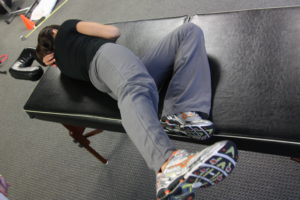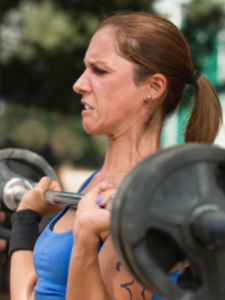- You are here:
- Home »
- Blog »
- Joint Health / Pain »
- Common Exercises for Knee Arthritis that Miss the Mark
Common Exercises for Knee Arthritis that Miss the Mark
This arrived in my in-box the other day with the headline – “Five Easy Exercises that Help Knee Arthritis”.
This type of advice is everywhere on the Internet and frankly is not all that helpful. Anyone with active knee arthritis – a sore, achy, or stiff knee – will tell you that at least a couple of these exercises hurt and most don’t help them move better or feel much better.
The exercises in this article, which are commonly used exercises for knee arthritis pain, focus on muscle strengthening. This creates a mismatch between the source of the problem – the joint – and the focus of the solution – muscle strengthening.
Knee strength for people with arthritis is built from the inside – out.
If you want stronger muscles, use muscle strengthening exercises. If you want a stronger joint, use joint strengthening exercises.
But before I explain, there are a couple of key concepts to understand.
The first one is “strength”.
Strength is the maximum amount of force your body can produce or absorb, with control, for a specific number of repetitions.
The repetition count can range from a low of 2 or 3 reps to a high between 15- 20 (there’s some disagreement about what constitutes strength development in terms of repetitions) but in each case, your muscles must experience fatigue.
Little to no fatigue means no strength gain.
This leads us to the second concept – “fatigue”.
Fatigue can be a vague thing for some people. What does it mean exactly and how do you know if what you’re feeling is correct?
Fatigue is something you feel and observe. You might feel a burning sensation in the muscles or a sense of tightness and you might notice difficulty completing the movement with control.
I once attended a Jazzercise class with my wife, Ellen and a friend of hers (I’m going to give you a few moments to visualize me in Jazzercise – yeah, it was Beyonce-esque).
One of the exercises was a side-lying leg lift.

Side-lying leg lift
After about 10 repetitions, my hip muscles were burning and the range of movement started to shrink. I glanced over at our friend and saw her studying her fingernails unphased by the challenge. Her leg looked like a windshield wiper in a hard rain. And since this was a timed exercise, I had a lot more reps in front me which I couldn’t do. Our friend, no problem.
The feelings in your muscle and the loss of control should happen within the rep range I mentioned earlier in order to build muscle strength.
For me, the side-lying hip lift was actually too hard. For our friend, it was too easy.
Strength is relative.
Another example.
Let’s suppose I have 25 pounds in my arms and want to perform a squat.
At 28 reps, I finally notice some burning in my quadriceps and a little difficulty in maintaining the form.
What does this mean? The weight or load is too light (or I could choose to move faster but for now let’s tinker with one variable at a time).
But, there’s a shortcut for figuring out the point at which the proper amount of fatigue has occurred.
If your face involuntarily contorts within the desired number of repetitions, you’re at about 70% of your maximum which is perfect (training to failure is risky and, for our purposes, unnecessary).[source]

Grimacing evidence of fatigue
Contort means something on your face moves without you actively doing it – facial grimacing – look at the photo and you’ll get the idea (and yes, I was grimacing during the hip lift).
And, by the way, competitive athletes make this mistake a lot – lifting a weight that’s too heavy. The idea is to hit the bullseye on reps, form, and fatigue.
I hope you’re not yawning yet. That’s involuntary too but hardly a strength thing.
Your body gets stronger only if you force it to by increasing the load. And the load can come from mass or speed. You’ll get stronger if you move a heavy load slowly or a lighter load quickly.
So, exercises like leg lifts, quad sets, hamstring stretches do almost nothing for leg strength and definitely nothing for joint strength (quad sets can help joint strength but not at the dosage typically suggested). Maybe, in the beginning, if your muscles are quite weak (like me with my Jazzercise class), there’s some strengthening effect but within a short time, you’ll need more load.
Now, exercises like a “Half Squat” and “One Leg Dip” have potential but two things have to happen.
First, if the movement hurts, the exercise is too hard and for many people, perhaps most, with knee arthritis (or hip or back), these exercises will often hurt.
In that case, you likely will not have any, or very little, fatigue since the movement and load will be too much for your joint (and too little for your muscles).
Second, assuming the movements don’t hurt, you need to feel fatigue by 15-20 repetitions at the most and preferably sooner. So, if you can crank out 25 reps, you need more load.
Then, as you add load, what happens? Your knee starts hurting (or it hurts the next day or so). We’re back where we started. Little to no muscle fatigue with a painful joint.
If your joint hurts, that means it’s weak. And yes, your leg muscles – your hip and thigh in particular – are likely weak too. Leg muscle strength is very important and a couple of the exercises in the article could help you with that but not at the expense of your joint. You’ll make more progress if you slow down and build strength in the joint and then build your muscle strength.
In order for your muscles to fatigue, your joint must be able to withstand the load required to challenge the muscles.
Thanks for reading.

P.S. – To learn more about how to strengthen joints, check out my#1 best-selling book The 90 Day Knee Arthritis Remedy available in PDF and on Amazon (which you can read using Amazon’s free Kindle app).
If you like this article, why not share it with a friend? If you’re interested in coaching services, please contact my colleague Laurie Kertz Kelly for a free, 20-minute Strategy Session by, clicking here. To get my Secret Weapon to fight knee, hip & back pain and stiffness, subscribe for free today.

Doug Kelsey has been a physical therapist and human movement expert since 1981. He is formerly Associate Professor and Assistant Dean for Clinical Affairs at the University of Oklahoma Health Sciences Center and the author of several books. He has conducted over 250 educational seminars for therapists, trainers, physicians, and the public and has presented lectures at national and international scientific and professional conferences. His professional CV is here.
